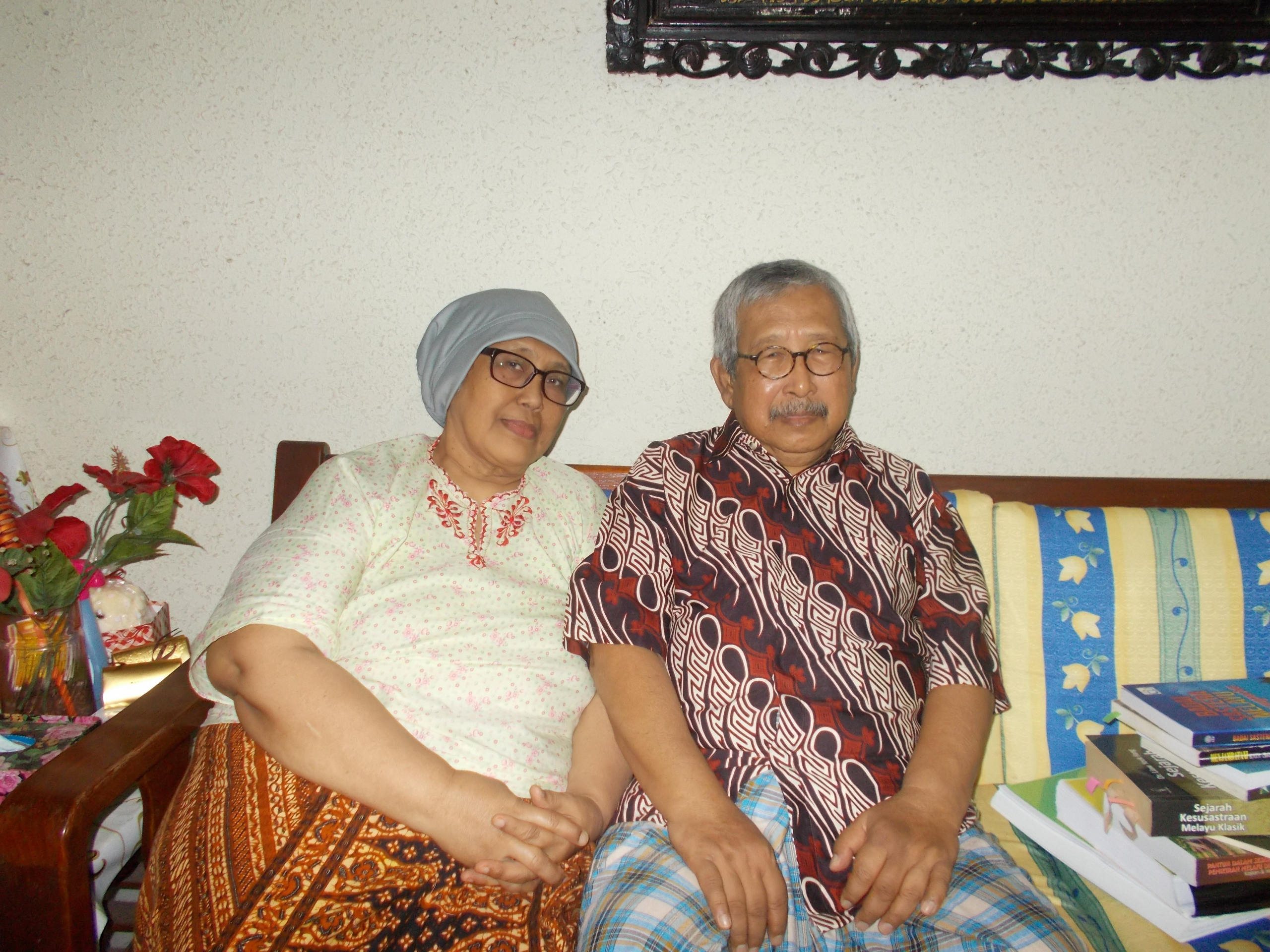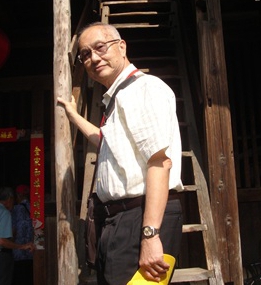以创作为己任的马来作家扎玛尔
文图·吴明珠

作家扎玛尔和太太麦穆娜都是诗人
扎玛尔位于义顺的五房式组屋在缺乏阳光的午后显得阴暗,乍看之下与其它的政府组屋没有两样。然而一踏进客厅,我的视线立刻被满屋的书本吸引。
作家面带笑容的迎接我。我来之前听说他一共有15,000本藏书。“一点也没有夸张。”他说,逐一把睡房一间间打开让我参观。我一看,果然三间房都像小型的图书馆。除了一张床,里面堆满厚薄不一的精装书和线装书,还有不计其数的马来语和兴地语的音乐和电影卡带,光碟及有关伊斯兰教的资料。他说:“我这里有些资料很罕见,马来西亚大学的学生会大老远地跑来要求复印资料。”
扫过书房以后我们在客厅的沙发上坐下,我从手提袋里拿出一本《源》杂志告诉他,我访问他的文章将会刊登在这一本杂志。许是因为看到华文引发他的回忆,他向我谈起许多年前旅游中国的事情。1994年他和我国著名的马来文翻译家杨贵谊和陈妙华伉俪以及三位马来籍的作家到中国云南省的昆阳旅游。“在那里我们参观了昆阳的一个村子,村子里住的全是回教徒,到处都是回教堂,我感觉那景观很有趣,很亲切。”
马来文化的活字典
72岁的扎玛尔·杜启明(Djamal Tukimin)是一部马来文化的活字典。他创作诗、小说、戏剧、马来文学和艺术评论,至今出版了一部小说《宗教老师》(IMAM),两本诗集 《第九座高峰》(Punchak Sembilan, 1975)和 《努山达拉之诗》(Puisi-Puisi),一本有关传统马来诗(班顿)的集子,四个剧本和两部有关马来作家和马来戏剧及表演艺术家的研究和评论。
他撰写的战后马来戏剧的发展史在我国是标准的参考书。他的讽刺剧《敦敦王梦里的黑水牛》(Seekor Kerbau Hitam Legam Dalam Mimpi Sang Pangeran Tom Tom)于1993年由我国资深的马来剧团Perkumpulan Seni搬上舞台。扎玛尔所创作的以伊斯兰教为主题的诗备受赞赏。南洋理工大学国家教育学院副教授哈蒂佳·拉赫马(Hadijah Rahmat)在她一篇论文中这样分析扎玛尔的诗:“扎玛尔试图通过对大自然和各种文化因素来探索有关宗教的课题。他也会在他创作的诗,包括以宗教为主题的作品里头描述妇女的形象。”
扎玛尔的诗作多次被公开朗读。他自己于2009年在滨海艺术中心朗读一个小时的诗。诗作也在2017年的妆艺节目中被朗诵。
以宗教为创作题材
与伊斯兰教有关的主题在扎玛尔的作品里占很大的成分。他说:“人家常常问我为什么以宗教为题材。我的答案是,在寻求一个安定而且有意义的人生过程中,唯一恒久不变的因素就是宗教。”
扎玛尔在1963年即出版一本短篇小说集,收 录多篇有关本地马来人的社会问题和困境。70年 代他成立一个叫GRUP GELORASA的诗社,通过 创作、讨论彼此的诗、在户外朗诵等形式,希望提 高普罗大众对诗的欣赏能力。
辛勤耕耘50多年,扎玛尔的成就终于得到认可。2007年荣获马来文学界最重要的敦斯里拉朗奖(Tun Seri Lanang Award),2015年荣获由泰国公主颁发的群岛诗人奖(Archipelago Poet Award),2017获得我国国家艺术理事会颁发的文化奖(Cultural Medallion)。
他说:“得奖是阿拉赐予我的特别的礼物。得奖让我有更强的信心去写作而且有能力出版新的作品。”
扎玛尔每天早上六点半起身,从早晨开始写作,下午小睡一下再继续写。晚饭后看一阵电视节目又继续写到半夜。
“写作对我来说不是一种兴趣,我不能呆坐着等灵感从天而降。写作是我对社会所尽的道德任务。”
扎玛尔所热衷的另一个领域是艺术评论。“我喜欢写评论,评论往往能透露一个艺术家在创作时的思考过程。”
思念芽笼士乃的小孩
扎玛尔在芽笼士乃(Geylang Serai) 出生,长大并一直住到70年代末。80年代因市区重建全家搬去大成巷 (Lorong Tai Seng),对老家念念不忘。“搬 家后我哭了好几天。芽笼是马来文化的核心和精神之家。我很想写一部有关这地区的小说。”扎玛尔把思乡之情宣泄在他最出名的诗《思念芽笼士乃的小孩》(Betapapun Nyanyian Rindunya Si Amak Geylang Serai)。全诗长达100多行,镶上玻璃镜框挂在他家客厅的墙上。芽笼士乃在六、七十年代是马来人集聚的地区,在当时属于繁华的地带。
小时候他父亲在公车总站卖沙爹(烤肉串),因家穷他穿拖鞋上学。中二因父亲去世而退学。好学的他大量阅读历史书、有关伊斯兰教的哲学书和多位著名诗人的作品,特别欣赏Masuri SN, Usman Awang。他挑起养家的担子,先是打杂,闲时到新加坡第一间工艺学校学木工,毕业后在一间工艺学校教授木工。
扎玛尔从事自由工作几十年。曾在我国电台的马来波道主持以马来文化为主题的节目,为马来报章撰写专栏,替人编辑文学刊物。有一段时间他去上英文课,后来竟能做翻译,替人把各种英文的文件翻译成马来文和印尼文。
班顿的爱好者
扎玛尔对马来传统诗“班顿”的创作颇有心得。班顿长短不一,短至两行,长达12行。他以坚定的语气说:“班顿的特色是含蓄,我们马来人不喜欢讲话太直,所以班顿诗人爱用象征创作。我觉得班顿是世界上最美丽的诗。有一位法国教授曾经说班顿不能被翻译成其他的语文。”
扎玛尔的生活也不单止是钻书堆。我们侃侃而谈,他的太太麦穆娜(Maimunah)在一旁聆听。她指着一堆放他膝上的书告诉我里头有一本情书集。扎玛尔笑笑地说:“那是我年轻时追求一个女孩子写的情书,这个人很早就去世了。”麦穆娜接着说:“这个女人不喜欢他。”我们都笑了起来。他们俩的情况又是怎样?扎玛尔说:“我和她一见钟情”。麦穆娜出生不平凡,她的父亲是学者和社区领袖。他们有五个儿子,11个孙,有两个媳妇是华人。
2009年到2011年扎玛尔应邀在马来西亚国家大学(National University of Malaysia)的马来世界及文明研究院(Malay World and Civilisation Institute)担任驻校研究员,麦穆娜每天到他的办公室,在一张小桌子旁边写诗。她写了千多首班顿,已结集成书。
祈望马来文化艺术蓬勃成长
扎玛尔还告诉我一个重要的资料。他说:“新加坡是马来文学和各类艺术的发源地,从1850年到1960年新加坡是马来文学、电影、音乐等领域的发展中心。莱佛士来了以后,发现这里收藏丰富的文献资料,便找人把这些资料翻译成英文出版,现在都收藏在大英图书馆。”
我问他现今马来人的情况如何?他说比以前好得多。“新加坡的马来人是全世界最好的马来人。”他希望马来文化与艺术在这里蓬勃成长。“我正在收集资料,希望出版一部 200年来马来戏剧的发展史。” 他目前正在写一部有关世界各地杰出的马来艺术家的集子。
虽然有高血压等健康问题,扎玛尔仍旧坚持写作,参与国外举办的马来文化的国际会议。他断然地说:“如果有一天我不能写作,我会失去生命。”
(作者为本刊特约记者)
AUTHOR WHO WRITES TO FULFILL SOCIAL RESPONSIBILITY
The five-room flat of author Djamal Tukimin in Yishun looked a little dark in the sunless afternoon but the minute I stepped into the sitting room I was drawn to the books that filled it. Djamal has a collection of 15,000 books. Some of them are so rare that Malaysian PhD students have come all the way to ask for permission to make a photocopy.
72-year-old Djamal is a walking encyclopedia of Malay culture. He has published two poetry collections, a tome on Pantun – traditional Malay poetry, a novel, a collection of short stories, four plays and at least two research books on Malay writers and performing artists. On his poems, Associate Professor Hadijah Rahmat said: “Djamal made an attempt to explore religious themes by combining it with nature and cultural elements. He also uses images of women in his poems, including his religious poems.” When asked why he favoured Islamic themes, he said that religion was the only consistent factor in one’s life in order to seek a safe and meaningful journey.” He likes Pantun and said it was the most beautiful genre of poetry in the world with its subtlety and the use of metaphor.
Djamal has received the Tun Seri Lanang Awardthe highest literary award in Malay literary field. He has also been conferred the Archipelago Poet Award given by the King of Thailand and the Cultural Medallion given by the Singapore Government. Djamal regards the awards as Alah’s special gift to him and is pleased with them because they give him confidence and the fund to publish new works. He grew up in Geylang Serai and after moving to Lorong Tai Seng, missed it so much that he cried for days. He was inspired to write his famous long poem about his longing for the old place (Betapapun Nyanyian Rindunya Si Amak Geylang Serai).
Djamal came from a poor family and after his father had passed away, shouldered the responsibility of caring for his family. He took on odd jobs, trained to be a carpenter and taught wood-work. Later on he hosted Malay Culture program on radio, wrote column for Malay newspaper and even did translation from English to Malay and Indonesian for clients. From 2009 to 2011 he was Fellow at the Malay World and Civilization Institute of the National University of Malaysia. His wife Maimunah has also written more than a thousand poems in Pantun.
Djamal said Singapore was the original spot for Malay culture and arts and that Sir Stamford Raffles had been instrumental in getting precious Malay resources translated from Malay to English. When asked what he thought about the state of Malays here, he said there was improvement over the years and declared proudly that “The Malays here are the best Malays in the world.” He hopes that Malay culture and art will thrive in Singapore. He writes for long hours daily and said that he would die if he could not write.




带领新加坡商务考察团重返武夷山.jpg)
在印度合影(图源:Tan-Chong-Tee-Force-136).jpg)
